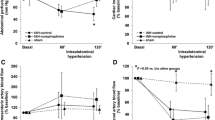Abstract
It is known that polycythemia decreases the fluidity of the blood and impairs tissue perfusion due to red-cell sludging in the microcirculation. In this study, the effect of polycythemic hyperviscosity (PH) on bowel necrosis was evaluated in an experimental model of intestinal ischemia. Twenty-eight Wistar albino rats (90–170 g) were divided into two groups: group 1 was transfused to create hyperviscosity and then intestinal ischemia was produced (n = 16); in group 2 ischemia was produced without transfusion (n = 12). Intestinal ischemia was produced by clamping the superior mesenteric artery and the collateral arcades of the right colic artery for 30 min. Gross and histopathologic evaluations were performed by either immediate necropsy or relaparotomy 24 h later. Microscopic findings were graded from 0 to 3 according to the degree of ischemic changes. In group 1, 2 animals (12.5%) died before 24 h postoperatively; coagulation necrosis with grade 2 or 3 ischemic changes was observed in 10 animals (62.5%). In group 2 only a few hypertrophied Peyer's patches and capillary dilation were found, and all histopathologic changes were between grades 0 and 1. The difference between the histopathologic gradings of the two groups was significant (P < 0.001). It appears that in addition to reduced splanchnic blood flow, a secondary effect of PH is needed to induce ischemic coagulation necrosis. PH of the newborn must be considered a risk factor for necrotizing enterocolitis, so-called spontaneous intestinal perforations, and even intestinal atresia.
Similar content being viewed by others
References
Abrams JS (1968) Experimental intestinal atresia. Surgery 64: 185–191
Aschner JL, Deluga KS, Metlay LA, Emmens RW HendricksMunoz KD (1988) Spontaneous focal gastrointestinal perforation in very low birth weight infant. J Pediatr 113: 364–367
Baum RS (1966) Viscous forces in neonatal polycythemia. J Pediatr 69: 975
Black VD (1982) Neonatal polycythemia and hyperviscosity. Ped Clin North Am 29: 1137–1148
Ballance WA, Dahms BB, Shenker N, Kliegman RM (1990) Pathology of necrotizing enterocolitis: a ten year experience. J Pediatr 117 (suppl) 6–13
Black VD (1987) Neonatal hyperviscosity syndromes. In: Lockhart JD (ed) Current problems in pediatric surgery. Year Book Med Publ, Chicago, pp 76–130
Black VD, Rumack CM, Lubchenco LO, Koops BL (1985) Gastrointestinal injury in polycythemic term infants. Pediatrics 76: 225–231
Çelik A, Salman T, Özbey H, Aksöyek S, Can G (1991) Neonatal gastrointestinal perforation. Pediatrik Cerrahi Dergisi 5: 140–143
Dunn SP, Gross KR, Scherer LR, Moenning S, Desanto A, Grosfeld J (1985) The effect of polycythemia and hyperviscosity on bowel ischemia. J Pediatr Surg 20: 324–327
Fasching G, Höllwarth ME, Schmidt B, Sauer H (1992) Necrotizing enterocolitis in very-low-birth-weight infants. Pediatr Surg Int 7: 428–430
Hathaway WE (1983) Neonatal hyperviscosity. Pediatrics 72: 567–569
Hebra A, Brown MF, Hirschl RB, McGeehin K, O'Neill JA, Norwood WI, Ross AJ (1993) Mesenteric ischemia in hypoplastic left heart syndrome. J Pediatr Surg 28: 606–611
Kliegman RM (1990) Models of the pathogenesis of necrotizing enterocolitis. J Pediatr 117 (suppl) 2–5
Kosloske AM (1990) A unifying hypothesis for pathogenesis and prevention of necrotizing enterocolitis. J Pediatr 117 (suppl) 68–74
Krashna IH, Howell C, Vega A, Ziegler M, Koop CE (1986) A mouse model for the study of necrotizing enterocolitis. J Pediatr Surg 21: 26–29
Leake RD, Thanopoulos B, Nieberg R (1975) Hyperviscosity syndrome associated with necrotizing enterocolitis. Am J Dis Child 129: 1192–1194
LeBlanc MH, D'Cruz C, Pate K (1984) Necrotizing enterocolitis can be caused by polycythemic hyperviscosity in the newborn dog. J Pediatr 105: 804–809
Linderkamp O, Versmold HT, Riegel KP, Betke K (1984) Contributions of red cells and plasma to blood viscosity in preterm and full-term infants and adults. Pediatrics 74: 45–51
Louw JH, Barnard CN (1955) Congenital intestinal atresia. Lancet Nov 19: 1065–1067
Megison SM, Jureta WH, Chao H, Walker PB (1990) A new model for intestinal ischemia in the rat. J Surg Res 49: 168–173
Meyer CL, Payne NR, Roback SA (1991) Spontaneous, isolated intestinal perforations in neonates with birth weight < 1,000 g not associated with necrotizing enterocolitis. J Pediatr Surg 26: 714–717
Musemeche CA, Kosloske AM, Bartow SA, Umland ET (1986) Comparative effects of ischemia, bacteria, and substrate on the pathogenesis of intestinal necrosis. J Pediatr Surg 21: 536–538
Nowicki P (1990) Intestinal ischemia and necrotizing enterocolitis. J Pediatr 117 (suppl) 14–19
Piet AMMA, Piet AB, Sakariassen KS, Heethaar RM, Sixma JJ (1983) Red blood cell size is important for adherence of blood platelets to artery subendothelium. Blood 62: 214–217
Smith MB, Smith L, Wells W, Shapira E, Hendrickson M, Moynihan PC (1991) Concurrent jejunal atresia with “apple peel” deformity in premature infants. Pediatr Surg Int 6: 425–428
Starc TJ (1992) Erythrocyte macrocytosis in infants and children with Down syndrome. J Pediatr 121: 578–581
Stoodley NG, Corbally MT, Speidel BD (1993) Simultaneous spontaneous isolated ileal perforation in twins. Pediatr Surg Int 8: 515–516
Velasquez OR, Granger ND, Crissinger KD (1992) Intestinal microcirculation in the neonate. Pediatr Surg Int 7: 408–414
Author information
Authors and Affiliations
Rights and permissions
About this article
Cite this article
Özbey, H., Boneval, C., Alkaç, Ü. et al. The effect of polycythemic hyperviscosity on ischemic bowel necrosis. Pediatr Surg Int 11, 547–549 (1996). https://doi.org/10.1007/BF00626063
Accepted:
Published:
Issue Date:
DOI: https://doi.org/10.1007/BF00626063




